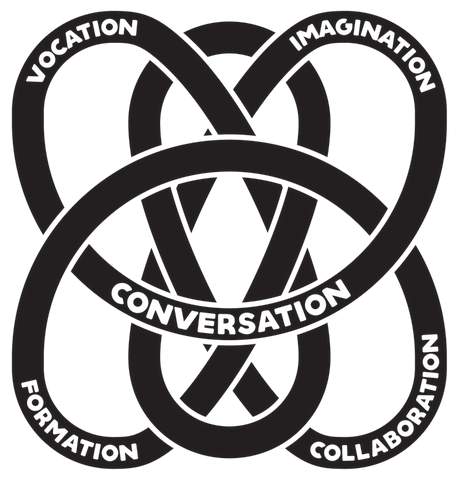How do ministers reflect on the strength of their ongoing call to a particular congregation or role?
Although the call to ministry in general may still be strong, sometimes there are cues to the fact that the relationship is becoming fragile or unsustainable.
My Celtic ''pastoral tie' graphic is an attempt to present the dynamics of a call in visual form.

My 2015 Masters of Business thesis identified a useful model by researching the salient features of a clergy evaluation - Formation, Collaboration, Imagination and fourthly Vocation. The methodology applied was Grounded Theory, an approach has as its overall the goal the expectation of building a theory. GTM researchers hope they can develop an integrative diagram, a visual device illustrating a coherent theoretical framework that will have disciplinary utility, contribute to the academic literature, or even just
This was indeed “discovery” - the archaeologist constructing a hypothetical house on the codes excavated from my participants’ data. The central construct of Conversation was used to describe the participatory nature of these reviews, and to view evaluation of clergy performance through an organisational lens.provide a researcher with the delight of constructive theory. I knew that a graphic or diagram constructed from the codes identified in participant data might suggest causes and connections in realistic and hopeful reviews, and could inform HRM practices in churches. The key function of such a diagram and its many iterations is to propel the researcher into thinking about how the emergent theoretical constructs relate to each other; boxes, circles and arrows will help represent causes and connections. For me the idea of a hand-drawn graphic came from a Grounded Theory study where the authors co-opted a colleague to draw their theory, and found the painting she produced enhanced their understanding and utilisation of the constructs (1). The Pastoral Tie graphic presented below was designed by a friend in response to my describing to her my own vision of Celtic-inspired array of ribbons, for which I had found graphic software representations inadequate.
Four other relevant constructs were portrayed as fields surrounding the Review Conversation nexus and described how reviews can function as effective instruments for both managing valuable human talent (organisational level) and testing the pastoral tie (individual level). When confidential, timely reviews are both realistic and hopeful, they can function to support ministry effectiveness and longevity, and help answer important organisational questions about the present and the future. The four salient features described in earlier posts describe practices that can engage, retain and develop valuable human talent in both denominations.
A review conversation allows evaluation to take place within a trusting relationship where problems are perceived as objective issues to be solved rather than personal inadequacies to be addressed. Within that strategic conversation, which can include normative, formative and restorative dimensions, key issues of vocation, formation, collaboration and imagination can be identified and explored. The central construct – Conversation – helps explain overall experiences of review, and endorsements and concerns expressed by the clergy of both streams. The second construct, Formation, connects review with spiritual and psychological learning and growth. Collaboration between elders and ministers in conducting and responding to a review is also important, and the fourth section looked at how review contributes to the pastor’s Imagination, in leading vision and managing change. Fifthly, the role of the review in shaping a minister’s sense of Vocation is significant, as well as organisational strategies to recruit and retain valuable human talent.
Although the four constructs and the central notion of the review conversation were explored separately, the Celtic-inspired ‘Pastoral Tie” graphic makes it clear that these features are looped and intertwined, and there is an interweaving of pairs in their influence in congregational life. The centre knot is made up of two ribbons, one stemming from history and the other from geography. History (and the denomination) provide the minister, with two strands of personal vocation and ongoing formation. Geography contributes the local parish, where minister and people exercise collaboration and imagination in discerning and executing their God-given mission. Vocation is looking back, Formation is looking in, Collaboration is looking between, and Imagination is looking forward, while the holistic review conversation will look all around. History and Geography are intertwined in the specific call of a pastor to a parish; the nexus or knot at the centre of the image signifies the engagement between pastor and parish, and represents the centrality of the testing of that call in ministers’ self-reflection and in this sample’s review experience.
There are many more interconnections.
The interface of Formation and Collaboration is seen in the concept of a learning organisation, where Christian formation is not just a matter for the individual pastor, but something that is embraced by everyone in the church - a culture of formation. Collaboration and Imagination overlap when the congregation is seeking to discern its vision of a shared desired future, in conversations where the “collective wisdom feels magical” (2). Imagination and Vocation work together when mission priorities in the “present future” shape organisational change, planting new congregations and fresh expressions of faith. Formation and Vocation intertwine as the churches take responsibility to equip, monitor and support the clergy they have sent out in ministry. Formation and Collaboration represent the now, Vocation and Imagination the future.
In clergy work these features are difficult to measure, but the chief tool that makes for mutual learning is still conversation that enables people to feel valued, involved and trusted (3). The salient features of collaboration and formation will maintain skill and commitment, while vocation addresses the wider goals of engagement and alignment. Imagination is more mysterious, but dimensions of flexibility and hope are key to organisational success in a changing world. This study’s key finding that clergy review is strategic, both for the individual and the organisation, means the pastoral tie model is a useful template for critical reflection on a minister’s work and a church’s mission. It also offers a perspective on congregational engagement, for a minister questioning their ongoing call. A minister reflecting on those four salient features with a reviewer will gain valuable insights into the strength or fragility of the pastoral tie, and enable them to plan well for the future.
The four salient features were found in both denominational contexts but there were subtle nuances. Baptist churches’ independence and autonomy can mean they are unhealthily isolated from outside scrutiny; limited understanding of issues of justice and ethics can lead to unsafe decisions. Baptist pastors may face unreasonable conflicting expectations, and brutally critical eldership teams, when what they most need is to know they are loved and supported. In Presbyterian polity, collegiality is essential because it “reflects spiritual gifts, protects the leadership from narrow horizons, allows for integration of special interests, limits individual power and compels the leaders to dialogue” (4). However with large presbyteries and fewer experienced clergy, time and resources may not be as dedicated to pastoral and judicative roles, and reciprocal trust and transparency may be compromised. A comparison of Baptist and Presbyterian experiences suggests that the main concern of the Presbyterians is for the clergy review not having enough ‘teeth’ to dissolve a pastoral tie, whilst the Baptists are more anxious about ‘teeth’ that are used too freely to terminate a call. Either way, there is room for the denominations to take a more proactive role in guiding Human Resource Management in the church.
To Think About: For congregants - how do you expect your pastor to test the strength of their ongoing call to your church? For clergy - how could reflecting on these features enhance your understanding and evaluations of the pastoral tie in your context?
Selected References:
1. Giske, T., & Artinian, B. (2007). A personal experience of working with classical grounded theory: from beginner to experienced grounded theorist. International Journal of Qualitative Methods, 6(4),
2. Brown, J., & Isaacs, D. (2005). The world café: shaping our futures through conversations that matter. P 210.
3. Rendle, G., & Mann, A. (2003). Holy conversations: strategic planning as a spiritual practice for congregations. Amazon Kindle.
4. Vischer, L. (Ed.). (1992). The Ministry of the Elders in the Reformed Churches. Berne, Switzerland: Swiss Federation of Protestant Churches. P 84
This article is part of a series introducing in more detail the findings of my 2015 Master of Business (AUT Auckland) where the thesis topic was performance management of clergy in NZ Presbyterian and Baptist churches. I looked at the changing business sector practices of Performance Management in knowledge work, examined the polity and processes of the nationally-mandated Presbyterian Ministry Development Reviews, and mined Baptist documents for evaluative practices applied in locally-governed congregations. Then I interviewed 15 senior ministers with a mixture of age, gender, ministry years and the two denominations, who had all experienced at least two reviews.
An introduction to the thesis findings "Realistic and Hopeful" can be found at http://godshapedlife.blogspot.co.nz/2016/05/clergy-reviews-realistic-and-hopeful.html
